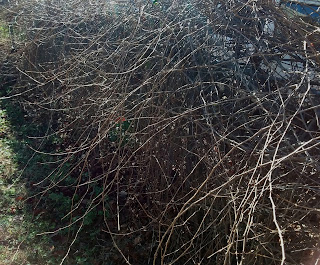
Muscadine vines in September
Before pruning
During pruning
After pruning
When we first moved into our central Virginia home, I purchased two Ison muscadine grape vines from Edible Landscaping in Afton, VA, and planted them along my chain link fence. This was an impulsive purchase, as I had never eaten a muscadine grape before. But, many of my earlier plant purchases were impulsive, and, luckily, I like muscadines fresh, as well as their juice and jelly. Muscadines are native to the southeastern US, but Ison is a cultivar.
Muscadines are vigorous growers and like to sprawl. After a long weekend, my neighbor found the vine had sent out tendrils that curled around the roof rack on his car! They also spread into adjacent trees and onto the carport next door (thank you tolerant neighbors!). Because they are so vigorous, they need heavy pruning and can easily tolerate it. Well, we have not heavily pruned these vines for maybe 10 years (bad, bad gardener!). The yield declined last year, so I knew it was time to prune. And I knew that the vine was dormant.
First, I inspected the vine. It had a mass of branches that came out about 2 feet on each side of the fence, plus many of these vines nearer the fence were dead. Then I checked to make sure the live vines were dormant. Cutting a moderate-sized one showed green wood, but very little moisture, and no dripping, so the sap was not running. I traced the line of the major branches, leaving those completely alone. I basically cut back everything else, especially the dead wood. The photos above illustrate the process (I did the best I could taking photos in the bright sunshine). These vines should rebound with vigorous growth in spring!
If you have grape vines, look for specifics on pruning, but it is essential to do it during dormancy. If you don't grow grapes, muscadines provide a good yield, though my neighbor grows Concord grapes to good effect!






